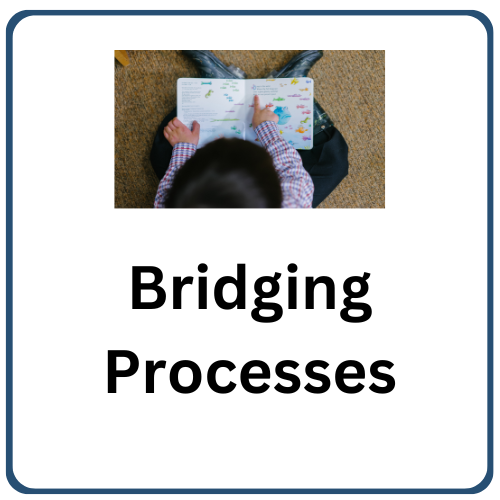
To become readers, students need to move between word recognition and language comprehension with increasing fluency. Bridging processes are the tools that readers use to do that. As shown in the Active View of Reading, bridging processes are how readers begin to weave together word recognition and language comprehension skills to become more fluent readers.
Each accordion below has self-paced asynchronous professional learning modules with a mix of video and text resources, opportunities for application and reflection, and contact hours.
If you would like a contact hour for your work, please e-mail Kathy.Bertini@maine.gov
- Reading Fluency
-
Use the links below to access the asynchronous professional learning modules and explore the resources.
- AIM Steps to Literacy Learning Modules - Module 7: Growing Proficient Readers
- Shifting the Balance: 6 Ways to Bring the Science of Reading into the Balanced Literacy Classroom (K-2), by Jan Burkins and Kari Yates - "Shifting the Balance" is a literacy book that provides practical strategies for teachers to bridge the gap between traditional phonics-based instruction and balanced literacy approaches. It aims to improve student outcomes by integrating research-based practices and offering actionable steps for enhancing reading instruction.
- Shifting the Balance, Grades 3-5: 6 Ways to Bring the Science of Reading into the Balanced Literacy Classroom, by Katie Cunningham, Jan Burkins, and Kari Yates - "Shifting the Balance" is a literacy book that provides practical strategies for teachers to bridge the gap between traditional phonics-based instruction and balanced literacy approaches. It aims to improve student outcomes by integrating research-based practices and offering actionable steps for enhancing reading instruction.
- Shifting the Balance: Grade 3-5 Downloads webpage: Reading Fluency Self-Assessment Tool
- Foundational Literacy Skills webpage provides information around:
- Reading Comprehension and Fluency slide deck
- Vocabulary
-
Use the links below to access the asynchronous professional learning modules and explore the resources.
- AIM Steps to Literacy Learning Modules - Module 4: Vocabulary
- Shifting the Balance, Grades 3-5: 6 Ways to Bring the Science of Reading into the Upper Elementary Classroom, by Katie Cunningham, Jan Burkins, and Kari Yates - "Shifting the Balance" is a literacy book that provides practical strategies for teachers to bridge the gap between traditional phonics-based instruction and balanced literacy approaches. It aims to improve student outcomes by integrating research-based practices and offering actionable steps for enhancing reading instruction.
- Shifting the Balance: Grade 3-5 Downloads webpage: Lesson Planning Template for Explicit Vocabulary Instruction
- Improving Adolescent Literacy: Effective Classroom and Intervention Practices (WWC Practice Guide) provides four evidence-based recommendations that teachers can use to deliver reading interventions to meet the diverse needs of their students.
- Adolescent Literacy Intervention Selection Tool (A-List Tool) provides information about literacy programs for grades 4-12 to help educators make informed intervention program choices.
- Creating Robust Vocabulary: Frequently Asked Questions and Extended Examples by Margaret G. McKeown, Linda Kucan, and Isabel L. Beck - this book provides robust practical strategies for vocabulary instruction for Tier 2 and Tier 3 words that can support literacy throughout content areas.
- Vocabulary Template for high-quality vocabulary instruction
- Foundational Literacy Skills webpage provides information around:
- Vocabulary and Spelling slide deck
- Morphology
-
Use the links below to access the asynchronous professional learning modules and explore the resources.
- Shifting the Balance, Grades 3-5: 6 Ways to Bring the Science of Reading into the Upper Elementary Classroom, by Katie Cunningham, Jan Burkins, and Kari Yates - "Shifting the Balance" is a literacy book that provides practical strategies for teachers to bridge the gap between traditional phonics-based instruction and balanced literacy approaches. It aims to improve student outcomes by integrating research-based practices and offering actionable steps for enhancing reading instruction.
- Shifting the Balance: Grade 3-5 Downloads webpage:
- Lesson Planning Template for Morphology Instruction
- Multi-year Plan for Systemic Morphology Instruction
- Shifting the Balance: Grade 3-5 Downloads webpage:
- Florida Center for Reading Research - Under the Vocabulary section, there are several morphology activities with printable materials and directions.
- Shifting the Balance, Grades 3-5: 6 Ways to Bring the Science of Reading into the Upper Elementary Classroom, by Katie Cunningham, Jan Burkins, and Kari Yates - "Shifting the Balance" is a literacy book that provides practical strategies for teachers to bridge the gap between traditional phonics-based instruction and balanced literacy approaches. It aims to improve student outcomes by integrating research-based practices and offering actionable steps for enhancing reading instruction.
- Graphophonological-Semantic Cognitive Flexibility
-
Graphophonological-semantic cognitive flexibility refers to a reader's ability to switch between Word Recognition and Language Comprehension as needed.
Use the links below to access the asynchronous professional learning modules and explore the resources.
- Active View of Reading - this page includes a general explanation of Graphophonological-semantic cognitive flexibility as well as a podcast with Nell Duke explaining it further.
- Executive Function Skills Supporting Literacy & Numeracy module explores the importance of these skills and strategies through the lenses of literacy and numeracy.
- Executive Function Strategies and Resources Padlet provides a variety of resources supporting executive function skills and strategies.